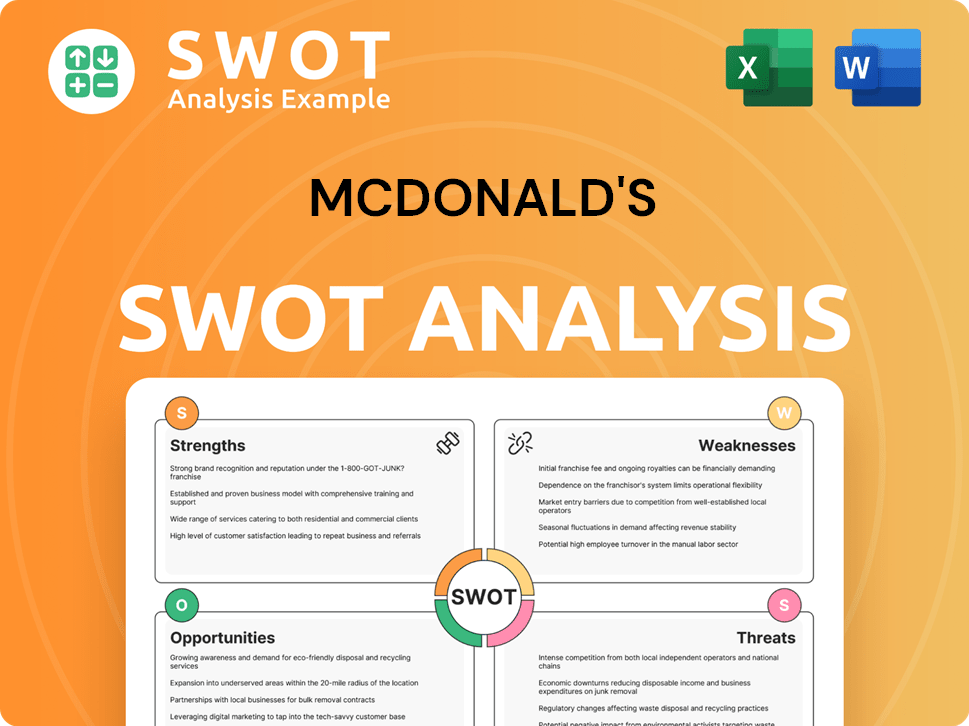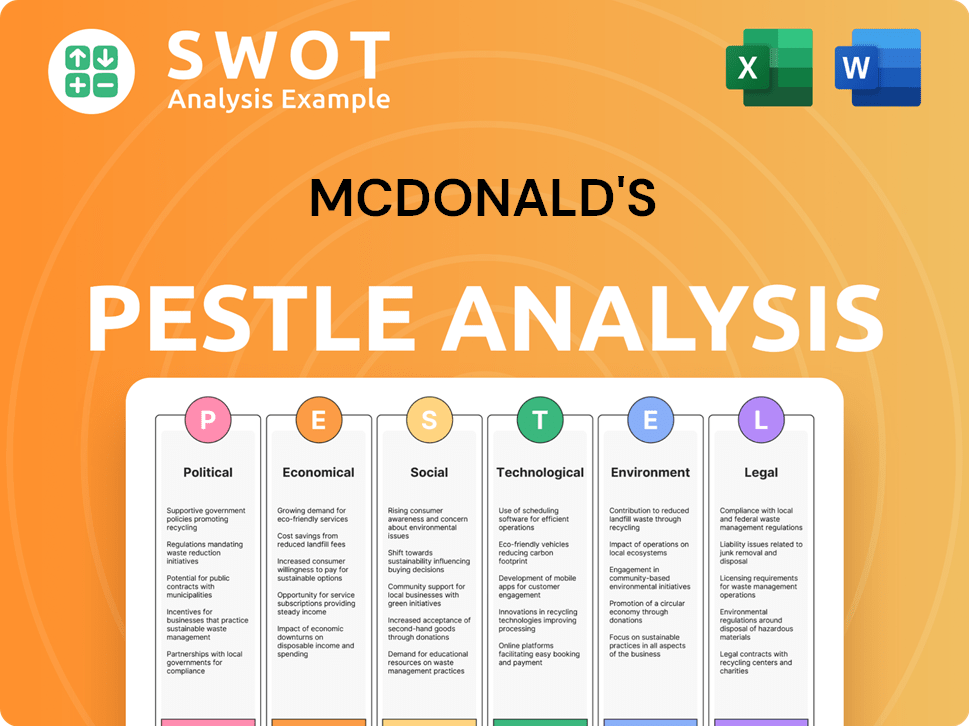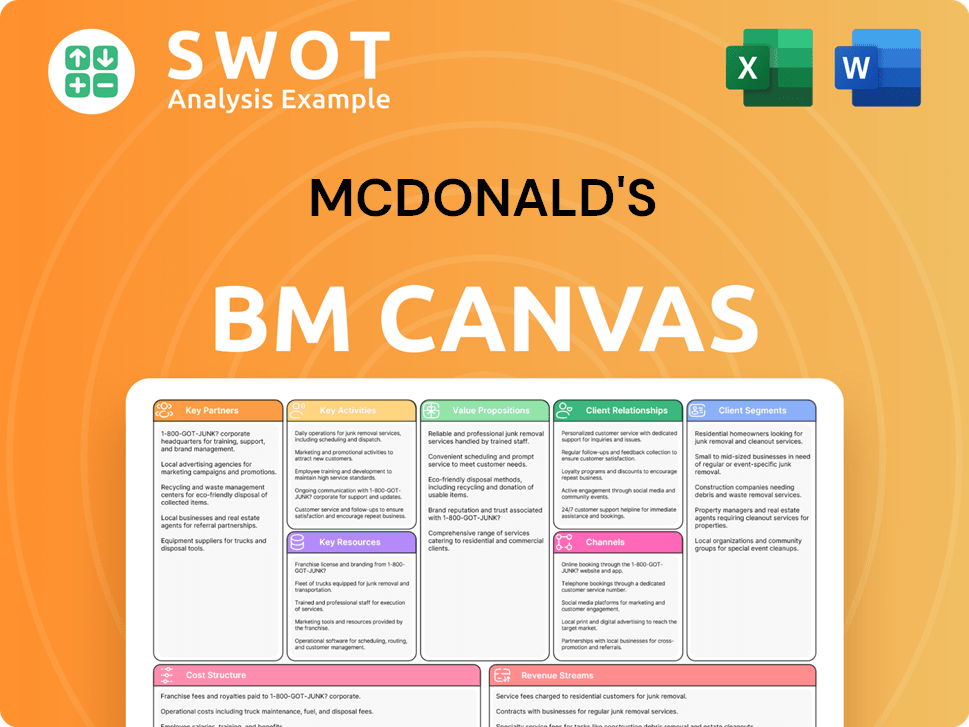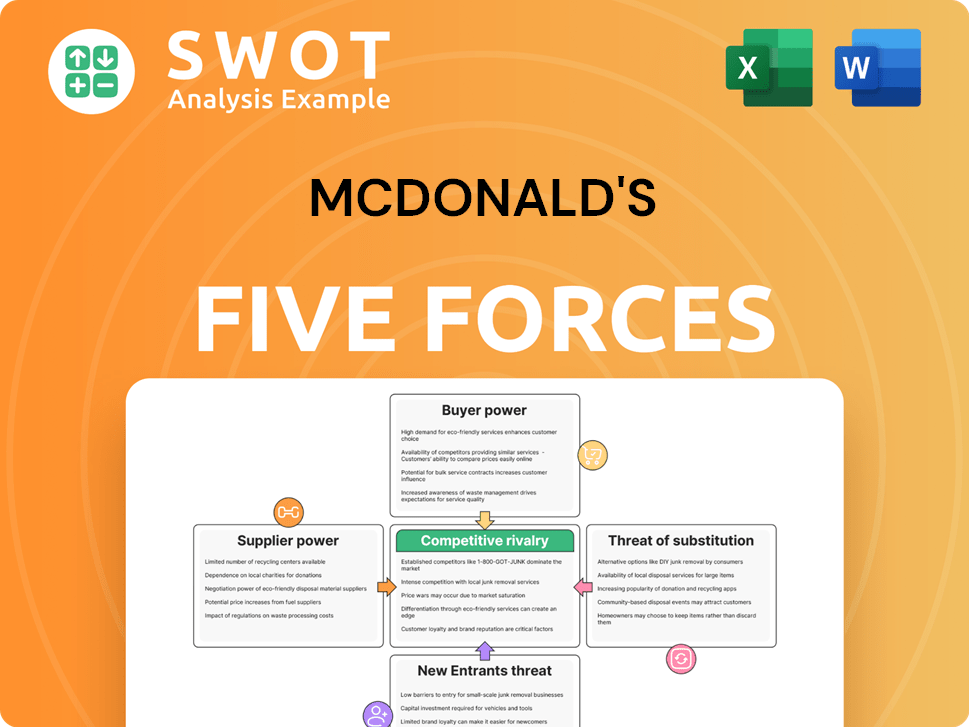McDonald's Bundle
How Does McDonald's Dominate the Fast-Food Arena?
The fast-food industry is a battlefield, and McDonald's is a seasoned general. Its strategic maneuvers, from digital transformations to menu innovations, are constantly reshaping the competitive landscape. Understanding McDonald's position requires a deep dive into its rivals and the tactics it employs to maintain its global dominance. This analysis is crucial for anyone looking to understand the McDonald's SWOT Analysis and its place in the market.

From its humble beginnings, McDonald's has evolved to become a titan, but what is McDonald's competition in 2024? Analyzing McDonald's market share and its rivals reveals a complex interplay of strategies and consumer preferences within the restaurant industry. This exploration of the competitive landscape will dissect McDonald's competitive advantages, its financial performance compared to competitors, and how it navigates the fast food industry's challenges.
Where Does McDonald's’ Stand in the Current Market?
McDonald's maintains a strong market position within the global quick-service restaurant (QSR) industry. The company consistently ranks among the top global food service retailers, based on systemwide sales and the number of restaurants. In the first quarter of 2024, McDonald's reported global comparable sales growth of 1.9%, demonstrating its continued strength in its core business. McDonald's vast global presence, operating in over 100 countries with more than 40,000 restaurants, allows it to cater to diverse customer segments.
The company's primary product lines include iconic hamburgers, cheeseburgers, french fries, and chicken products. These offerings remain central to its menu, alongside breakfast items and a growing range of beverages and desserts. McDonald's has strategically shifted its focus towards digital transformation, investing in mobile ordering, delivery services, and personalized customer experiences to enhance convenience and appeal to tech-savvy consumers. This digital emphasis is reflected in its strong digital sales, which accounted for over $9 billion in the first quarter of 2024 across its top six markets.
Financially, McDonald's shows robust health compared to industry averages. As of the first quarter of 2024, the company reported revenues of approximately $6.17 billion. Its substantial scale and strong cash flow generation provide a significant advantage, enabling continued investment in technology, restaurant modernization, and marketing. While McDonald's holds a particularly strong position in established markets like the United States and Western Europe, it continues to focus on growth opportunities in emerging markets, where QSR penetration may be lower.
McDonald's holds a significant portion of the fast food industry market share globally. It operates in over 100 countries, with more than 40,000 restaurants worldwide, many of which are franchised. This extensive reach allows it to serve a diverse customer base, from families to individuals seeking convenient meal options.
McDonald's has invested heavily in digital technologies, including mobile ordering and delivery services, to enhance customer experience. Digital sales accounted for over $9 billion in the first quarter of 2024 across its top six markets. The company continues to innovate with new menu items and marketing strategies to stay competitive.
In the first quarter of 2024, McDonald's reported revenues of approximately $6.17 billion. Its strong financial performance allows for continued investment in technology and marketing. The company's robust financial health provides a competitive advantage in the restaurant industry.
McDonald's employs various strategies to maintain its market position, including menu diversification and geographical expansion. The company focuses on adapting to changing consumer preferences by introducing new menu items and healthier options. For more details on their approach, see the Marketing Strategy of McDonald's.
McDonald's faces intense competition in the fast-food market, requiring continuous adaptation and innovation. Key factors include brand recognition, global presence, and digital capabilities. Understanding McDonald's competition and its strategies is crucial for its continued success.
- Menu innovation and adaptation to changing consumer preferences.
- Strategic investments in digital technologies and customer experience.
- Geographical expansion and market penetration in emerging markets.
- Maintaining a strong financial position to support growth initiatives.
McDonald's SWOT Analysis
- Complete SWOT Breakdown
- Fully Customizable
- Editable in Excel & Word
- Professional Formatting
- Investor-Ready Format

Who Are the Main Competitors Challenging McDonald's?
The competitive landscape for McDonald's is incredibly diverse, encompassing a wide array of rivals vying for market share in the global quick-service restaurant (QSR) industry. McDonald's competition is fierce, with both direct and indirect competitors constantly innovating and adapting to consumer preferences. This dynamic environment requires McDonald's to continually refine its strategies to maintain its position.
Understanding McDonald's rivals is critical for a thorough competitive analysis. The fast food industry is characterized by intense competition, with companies constantly striving to attract customers through various means, including menu innovation, pricing strategies, and marketing campaigns. Analyzing these competitive dynamics provides insights into the challenges and opportunities McDonald's faces.
McDonald's faces a complex competitive environment. Key competitors include direct rivals like Burger King and Wendy's, as well as indirect competitors from different QSR segments. These competitors challenge McDonald's through product offerings, pricing, and marketing efforts. Furthermore, emerging players and market trends add to the complexity of the competitive landscape.
Burger King, a subsidiary of Restaurant Brands International, is a major direct competitor, known for its flame-grilled burgers. Wendy's, another key rival, differentiates itself with fresh beef and a focus on quality ingredients. These competitors often engage in aggressive promotional strategies to gain market share.
Yum! Brands, with KFC, Pizza Hut, and Taco Bell, presents a significant challenge with its diverse menu. Starbucks competes for breakfast and snack occasions, leveraging its strong brand and digital presence. Subway, with its customizable sandwiches, also competes for the quick meal market.
Product launches, such as the ongoing competition for chicken sandwiches, are common. Value menu offerings are also a key strategy to attract price-sensitive consumers. Market share shifts are influenced by successful marketing and operational efficiencies.
Fast-casual chains like Chipotle Mexican Grill are disrupting traditional fast-food models. The rise of ghost kitchens and third-party delivery platforms intensifies competition by lowering barriers to entry. Mergers and acquisitions, such as Inspire Brands' acquisitions, impact competitive dynamics.
McDonald's market share is constantly challenged by its competitors. Burger King, Wendy's, and Yum! Brands are always vying for a larger piece of the pie. The ability to adapt to changing consumer trends is crucial for maintaining or growing market share.
McDonald's responds to competitive pressures through menu innovation, digital initiatives, and operational improvements. The company focuses on enhancing customer experience and adapting to evolving consumer preferences. Effective marketing campaigns play a key role in attracting and retaining customers.
The competitive landscape is shaped by various factors, including pricing strategies, menu innovation, and marketing effectiveness. McDonald's must continually assess its competitive advantages and adapt to market changes to maintain its leading position. For a deeper dive, consider exploring the Growth Strategy of McDonald's.
Several factors influence McDonald's competition and market share. These include pricing, menu innovation, and marketing effectiveness. McDonald's must continually evaluate its strategies to stay ahead.
- Pricing Strategies: Value menus and promotional offers are critical for attracting price-sensitive consumers.
- Menu Innovation: Introducing new products and adapting to changing tastes is essential.
- Marketing and Branding: Effective campaigns build brand loyalty and attract customers.
- Digital Initiatives: Mobile ordering and delivery services enhance convenience.
- Operational Efficiency: Streamlining operations improves customer service and profitability.
McDonald's PESTLE Analysis
- Covers All 6 PESTLE Categories
- No Research Needed – Save Hours of Work
- Built by Experts, Trusted by Consultants
- Instant Download, Ready to Use
- 100% Editable, Fully Customizable

What Gives McDonald's a Competitive Edge Over Its Rivals?
The competitive landscape for McDonald's is shaped by its significant advantages in the fast food industry. These advantages have allowed it to maintain a leading position, despite facing intense competition. Understanding these strengths is crucial for assessing its performance and future prospects. A deep dive into Brief History of McDonald's reveals the foundations of its success.
McDonald's competitive advantages are multifaceted, encompassing brand recognition, operational efficiency, and a robust financial base. Its global presence and strong brand equity provide a significant edge, fostering customer loyalty and trust. The company's ability to innovate and adapt to changing consumer preferences is also key to its continued success. Evaluating these factors is essential for a comprehensive McDonald's competition analysis.
The company's strategic moves, such as investments in technology and menu diversification, have further strengthened its position. These initiatives, combined with its established supply chain and franchise model, contribute to its resilience in a dynamic market. McDonald's market share reflects the effectiveness of these strategies.
McDonald's boasts unparalleled brand equity, with its golden arches recognized worldwide. This global presence fosters customer trust and loyalty, providing a significant competitive advantage. The company's consistent branding and marketing efforts reinforce its position in the fast food industry.
With over 40,000 restaurants globally, McDonald's benefits from massive purchasing power, securing favorable prices. Its efficient supply chain ensures consistent product availability and quality. The franchise model enhances distribution, adapting to local preferences.
McDonald's 'Speedee Service System' ensures speed and consistency in food preparation and service. Continuous investments in technology, like self-ordering kiosks, streamline operations. This operational efficiency is crucial in the fast food industry.
A robust talent pool and well-established training programs ensure consistent service across restaurants. This focus on employee development supports operational excellence. McDonald's invests significantly in its workforce to maintain high standards.
McDonald's competitive advantages are a result of its strong brand, operational efficiency, and strategic investments. These advantages enable the company to maintain its market leadership and adapt to changing consumer demands. The company's focus on innovation and customer experience further strengthens its position in the fast food market.
- Brand Equity: Global recognition and customer trust.
- Economies of Scale: Purchasing power and efficient supply chain.
- Operational Efficiency: Speedee Service System and technology integration.
- Talent and Training: Consistent service and operational execution.
McDonald's Business Model Canvas
- Complete 9-Block Business Model Canvas
- Effortlessly Communicate Your Business Strategy
- Investor-Ready BMC Format
- 100% Editable and Customizable
- Clear and Structured Layout

What Industry Trends Are Reshaping McDonald's’s Competitive Landscape?
The quick-service restaurant (QSR) sector is experiencing significant shifts, impacting McDonald's competition and market position. The industry is driven by technological advancements, evolving consumer preferences, and regulatory pressures. McDonald's market share is constantly challenged by both established and emerging players, necessitating continuous adaptation and innovation to maintain its competitive edge in the fast food industry.
McDonald's rivals face similar challenges, including adapting to digital transformation and meeting changing consumer demands for healthier and more sustainable options. Regulatory changes, such as those concerning labor practices and environmental sustainability, also pose challenges. The company's ability to navigate these trends and adapt its strategies will be crucial for its future success. This competitive landscape requires continuous strategic adjustments to stay ahead.
Technological integration, including mobile ordering and delivery services, is transforming the fast food industry. Consumer preferences are shifting towards healthier options and plant-based alternatives, influencing menu innovation. Regulatory changes related to nutrition and sustainability also impact operations.
Increased competition from fast-casual restaurants and virtual brands presents a challenge. Economic shifts, like inflationary pressures, can impact raw material costs and consumer spending. Navigating a complex web of global regulations requires significant compliance efforts.
Growth opportunities exist in emerging markets with rising disposable incomes and urbanization. Product innovations, like plant-based offerings and AI-driven personalized menus, can unlock new revenue streams. Strategic partnerships can enhance reach and capabilities.
Emphasis on digital transformation, menu diversification, and sustainable practices is crucial. Leveraging the franchisee network for local adaptation is key. Investing in cutting-edge technology and supply chain optimization will further strengthen its competitive position.
The competitive analysis of McDonald's reveals a landscape shaped by both established and emerging players. McDonald's must continuously innovate to maintain its market leadership in the restaurant industry. Understanding its target audience, as discussed in Target Market of McDonald's, is also essential for strategic decisions.
- McDonald's faces competition from major players like Burger King, KFC (Yum! Brands), and Subway.
- Fast-casual restaurants such as Chipotle and Panera Bread are also significant competitors, attracting customers with perceived higher quality and customization.
- Emerging virtual brands and ghost kitchens add to the competitive pressure by offering convenience and lower overhead costs.
- The company's strategies include digital transformation, menu diversification, and sustainable practices.
McDonald's Porter's Five Forces Analysis
- Covers All 5 Competitive Forces in Detail
- Structured for Consultants, Students, and Founders
- 100% Editable in Microsoft Word & Excel
- Instant Digital Download – Use Immediately
- Compatible with Mac & PC – Fully Unlocked

Related Blogs
- What are Mission Vision & Core Values of McDonald's Company?
- What is Growth Strategy and Future Prospects of McDonald's Company?
- How Does McDonald's Company Work?
- What is Sales and Marketing Strategy of McDonald's Company?
- What is Brief History of McDonald's Company?
- Who Owns McDonald's Company?
- What is Customer Demographics and Target Market of McDonald's Company?
Disclaimer
All information, articles, and product details provided on this website are for general informational and educational purposes only. We do not claim any ownership over, nor do we intend to infringe upon, any trademarks, copyrights, logos, brand names, or other intellectual property mentioned or depicted on this site. Such intellectual property remains the property of its respective owners, and any references here are made solely for identification or informational purposes, without implying any affiliation, endorsement, or partnership.
We make no representations or warranties, express or implied, regarding the accuracy, completeness, or suitability of any content or products presented. Nothing on this website should be construed as legal, tax, investment, financial, medical, or other professional advice. In addition, no part of this site—including articles or product references—constitutes a solicitation, recommendation, endorsement, advertisement, or offer to buy or sell any securities, franchises, or other financial instruments, particularly in jurisdictions where such activity would be unlawful.
All content is of a general nature and may not address the specific circumstances of any individual or entity. It is not a substitute for professional advice or services. Any actions you take based on the information provided here are strictly at your own risk. You accept full responsibility for any decisions or outcomes arising from your use of this website and agree to release us from any liability in connection with your use of, or reliance upon, the content or products found herein.